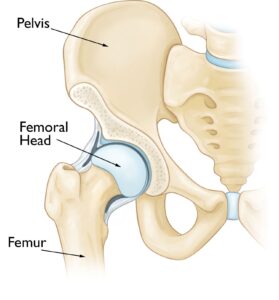One inspiring cue:
Once you grab your foot in Dancer’s Pose, find neutral in your spine and pelvis. Then, as you hinge forward, begin getting more extension in the lifted leg by MOVING YOUR LEG (HEAD OF FEMUR) UP AND AROUND THE BACK OF THE PELVIS. You pelvis will most likely tilt forward a little bit, but try to allow the action of the leg lifting up and around the pelvis be what takes you deeper into the pose. This is been a true game changer for me!

Why?
Finding more extension in the lifted leg, when done properly, can make the pose both safer and deeper. Susi Hately, author of Anatomy and Asana: Preventing Yoga Injuries says, “For the legs to move into extension, the femurs must move into extension at the hip joints. For femurs to move this way, the pelvis must remain stable. From a stable pelvis, the gluteus maximus and hamstrings contract, causing the femurs to lift into extension.”
Remember that all cues do not work for all bodies, as we are highly unique in our structure. This cue, for my body, has made any backbend that I practice not only feel deeper, but much more comfortable/stable. I highly recommend scrolling down and giving this week’s tip a try as a way to begin working with the cue.
One inspiring tip:
Come all the way into your Dancer’s Pose with a neutral spine and your heel close to your glute (see image below). Once you’ve arrived and feel balanced, lift your leg up towards the sky with minimal movement in your pelvis. Your upper back (thoracic spine) will move into extension (deeper backbend) as your leg moves into extension from the lifting action.

One inspiring song:
“I And Love and You” by The Avett Brothers
One inspiring quote:
“It is not joy that makes us grateful; it is gratitude that makes us joyful.”
– David Steindl-Rast
Nutrition nugget:
TRYPTOPHAN
If you remember from my last newsletter, Tryptophan (also called L-tryprophan) is an essential amino acid that may have the benefits of being a natural mood regulator as well as reducing depression, anxiety, and headaches.
Do you or anyone you know get migraines? Consider making sure you/they are getting enough daily Tryptophan. “A 2019 study revealed that subjects who had a median intake of nearly 1 gram of Tryptophan per day reduced their odds of developing a migraine by nearly 60 percent.” 1 gram = 1000 milligrams
Here is a reminder of what foods contain Tryptophan from Dr. Axe’s article that I shared earlier this month:
- Roast lamb (3 ounces) – 353 mg
- Chicken breast (3 ounces) – 343 mg
- Pumpkin seeds (2 ounces) – 328 mg
- Skirt steak (3 ounces) – 318 mg
- Ground turkey (3 ounces) – 306 mg
- Salmon (3 ounces) – 285 mg
- Tuna fillet (3 ounces) – 285 mg
- Roast turkey breast (3 ounces) – 244 mg
- Firm tofu (3 ounces) – 222 mg
- Edamame (3 ounces) – 156 mg
- Canned sardines (3 ounces) – 154 mg
- Eggs (two) – 154 mg
- Hamburger patty, 97% lean (ounces) – 114 mg
- Oatmeal (one cup cooked) – 94 mg
- Red kidney beans (3 ounces) – 74 mg
- Spinach (one cup cooked) – 72 mg
If you are interested in knowing more about Tryptophan, click here for Dr. Axe’s entire article.

